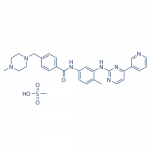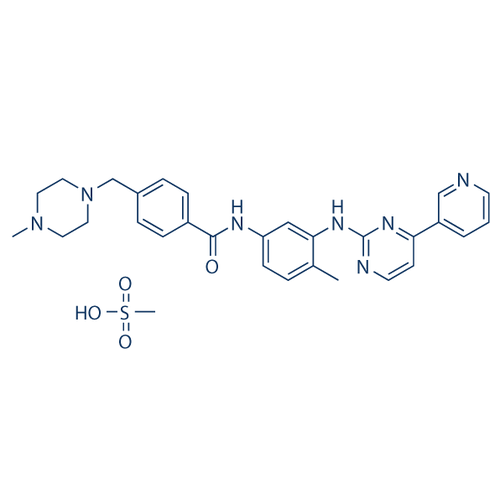| Product Name | Imatinib mesylate |
| Description |
Kinase inhibitor |
| Purity | >98% (HPLC) |
| CAS No. | 152459-95-5 |
| Molecular Formula | C30H35N7O4S |
| Molecular Weight | 589.7 |
| Field of Use | Not for use in humans. Not for use in diagnostics or therapeutics. For in vitro research use only. |
Properties
| Storage Temperature | -20ºC |
| Shipping Temperature | Shipped Ambient |
| Product Type | Inhibitor |
| Solubility | Soluble H2O: soluble10 mg/ml, clear |
| Source | Synthetic |
| Appearance | White to beige solid |
| SMILES | C5=C(C1=CN=CC=C1)N=C(NC2=C(C=CC(=C2)NC(C3=CC=C(C=C3)CN4CCN(CC4)C)=O)C)N=C5 |
| InChI | InChI=1S/C29H31N7O/c1-21-5-10-25(18-27(21)34-29-31-13-11-26(33-29)24-4-3-12-30-19-24)32-28(37)23-8-6-22(7-9-23)20-36-16-14-35(2)15-17-36/h3-13,18-19H,14-17,20H2,1-2H3,(H,32,37)(H,31,33,34) |
| InChIKey | KTUFNOKKBVMGRW-UHFFFAOYSA-N |
| Safety Phrases |
Classification: Acute toxicity, Oral (Category 4), H302 Safety Phrases: S22 - Do not breathe dust. S24/25 - Avoid contact with skin and eyes. S36/37/39 - Wear suitable protective clothing, gloves and eye/face protection. Hazard statements: H302 Harmful if swallowed. Precautionary statements: P264 Wash skin thoroughly after handling. P270 Do not eat, drink or smoke when using this product. P301 + P312 IF SWALLOWED: Call a POISON CENTER or doctor/ physician if you feel unwell. P330 Rinse mouth. P501 Dispose of contents/ container to an approved waste disposal plant. |
| Cite This Product | Imatinib mesylate (StressMarq Biosciences Inc., Victoria BC CANADA, Catalog # SIH-453) |
Biological Description
| Alternative Names | 4-[(4-Methyl-1-piperazinyl)methyl]-N-[4-methyl-3-[[4-(3-pyridinyl)-2-pyrimidinyl]amino]-phenyl]benzamide methanesulfonate, 4-[(4-Methylpiperazin-1-yl)methyl]-N-(4-methyl-3-{[4-(pyridin-3-yl)pyrimidin-2-yl]amino}phenyl)benzamide mesylate, CGP 57148, Genfatinib, Glivec, Imatinib methanesulfonate, STI-571 |
| Research Areas | Apoptosis, Cancer, Cancer Growth Inhibitors, Cell Signaling, Tyrosine Kinase Inhibitors |
| PubChem ID | 5291 |
| Scientific Background | Imatinib Mesylate is a tyrosine kinase inhibitor that selectively targets Bcr-Abl, c-Kit, and platelet-derived growth factor receptors (PDGFR). While primarily used in oncology, Imatinib has gained interest in neuroscience for its potential to modulate neuroinflammatory and neurodegenerative pathways. PDGFR signaling is involved in blood-brain barrier integrity, glial activation, and neuronal survival. Inhibition of PDGFR by Imatinib may reduce neuroinflammation and protect against neuronal damage in models of stroke, multiple sclerosis, and Alzheimer's disease. Its ability to cross the blood-brain barrier and influence kinase-driven signaling cascades makes it a valuable tool for exploring therapeutic strategies in neurodegenerative disease research. |
| References | 1. Kantarjian H., et al. (2002). N.E. J. Med. 346(9): 645–652. |



Reviews
There are no reviews yet.